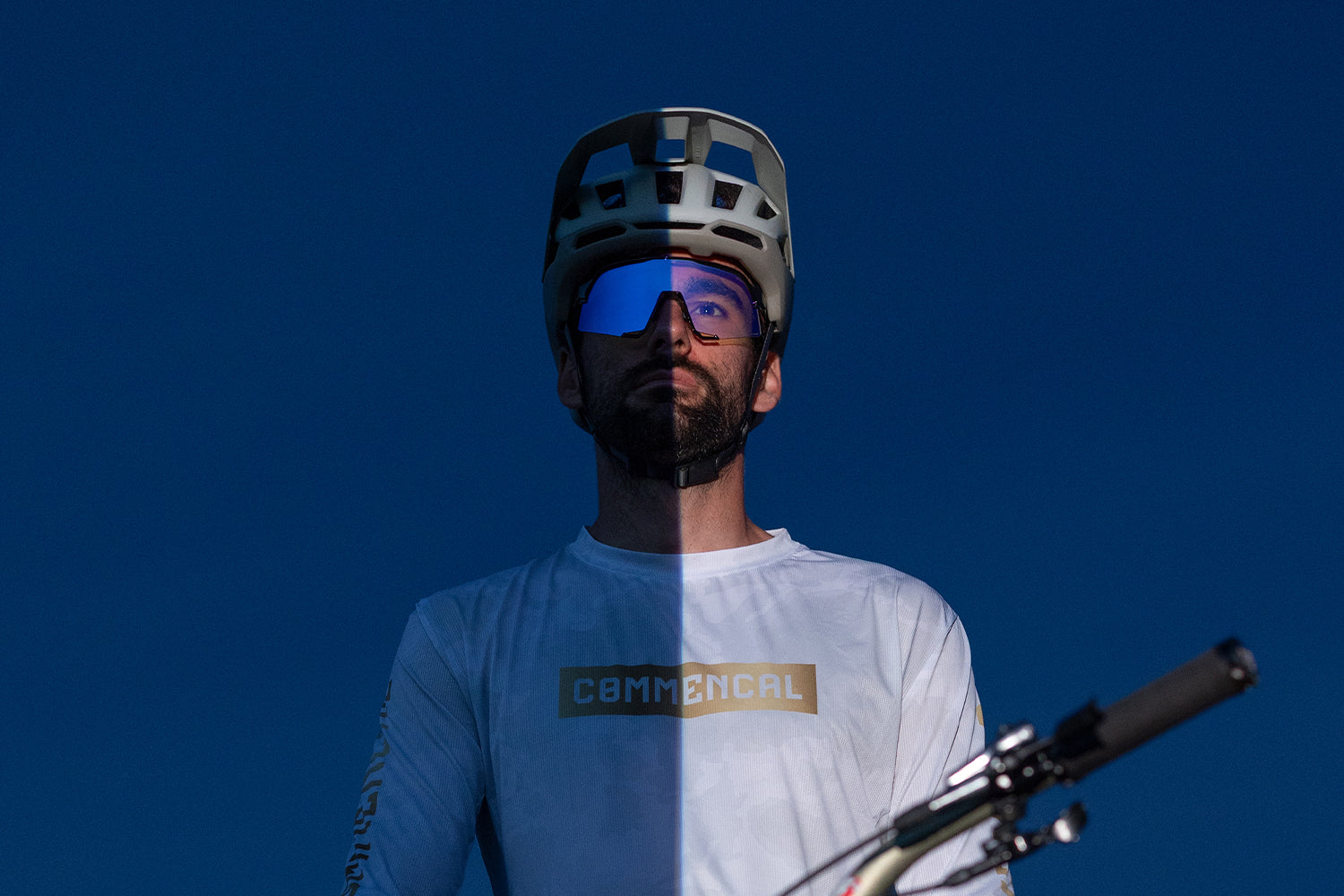Polarized lenses can be a huge asset to some sports – but are they your best choice for ski and snow goggles? In this article we take a deep dive into what polarization is and the specific benefits of polarized snow goggles out on the slopes.
What polarization is and why it matters
Polarization is designed to improve visual clarity and comfort in brightly lit snow-covered landscapes. This technology works by incorporating a special chemical layer within the lens that filters and blocks certain orientations of light waves, specifically horizontal waves, which are responsible for the harsh glare produced by sunlight reflecting off the snow’s surface. This glare can be distracting but also is potentially dangerous, as it can obscure vision, making it difficult for you to identify obstacles, variations in terrain and changes in snow conditions.
Polarized lenses can significantly reduce eye strain – prolonged exposure to bright reflections can lead to discomfort, squinting, and in some cases even temporary vision impairment known as snow blindness. Polarized lenses allow you to focus on performance, rather than worrying about glare.
Polarized lenses can also help you discern nuances in the snow’s surface such as ice patches and moguls, which are crucial for safety and technique.
Particular benefits of polarization for winter sports
While polarized lenses are common in many sports, including baseball and motocross, they have a few particular benefits for those participating in winter sports due to their unique advantages in snowy and icy conditions.
Reduction in glare
We’ve touched on this already, but one of the main reasons polarized lenses are so popular in winter sports is because they can significantly reduce glare and harsh reflections in bright, sunny conditions. Selective blocking of light waves enhances clarity and reduces blinding, making them ideal for the bright and reflective environments we encounter in snow sports.
Improved contrast and visual depth
The same selective light-blocking techniques that can reduce glare also help to filter out horizontal glare that washes out colors and details on the snow. This allows the eyes to perceive the environment with greater clarity and depth, making it easier for the wearer to distinguish contours, textures and changes in terrain. As a result, it’s easier to navigate slopes, spot obstacles and react to changes more effectively and efficiently, enhancing both your performance and safety.
Reduction in eye strain and fatigue
When the eyes are subject to glare for prolonged periods of time, this glare can force the eyes to work harder to focus and lead to strain and fatigue. By filtering out harsh, reflected light, polarized lenses help the eyes to relax, reducing squinting and therefore reducing fatigue associated with constant glare exposure. This makes it easier for you to stay focused and comfortable, even after extended periods in bright and snowy conditions.
Improved wet condition visibility
Polarized lenses improve wet condition visibility in exactly the same way as they do in bright conditions – by reducing the glare that is reflected off wet surfaces. When light reflects off wet snow or ice, it can create blinding glare that will reduce and obscure vision. Polarized lenses block this harsh reflected light, allowing for clearer and more defined vision.
Better color saturation
Excessive glare in bright and snowy conditions can wash out colors and make it very difficult to distinguish obstacles and objects in the snow. Polarized lenses’ filtration of certain wavelengths of light allow the colors of the environment to come through more vividly, enhancing the visual contrast between the snow and the rest of the environment – contributing to better safety, performance and enjoyment on the slopes.
How to choose the right polarized snow goggles
While there are lots of reasons a new pair of polarized goggles might be right for you, there are some considerations when choosing new goggles that you should be aware of. Make sure you follow these to ensure comfort, safety and performance.
Fit and Comfort
Ensure the goggles fit snugly over your face without pressing too hard against your skin. They should work well with your helmet, if you wear one, without leaving gaps that could let in air or snow. Some goggles come with adjustable straps and foam padding for a better fit and added comfort.
Lens Quality
High-quality polarized lenses are key. Look for lenses with strong polarization technology to effectively reduce glare. Additionally, consider lenses with UV protection to shield your eyes from the sun’s harmful rays.
Lens Tint and Light Transmission
Different tints suit different weather conditions. For bright, sunny days, darker tints like gray can be more beneficial, whereas for overcast conditions, lighter tints like yellow or gold improve contrast and depth perception. The Visible Light Transmission (VLT) percentage indicates how much light the lens allows through, affecting how well you can see in various conditions.
Ventilation and Anti-Fog Features
Good ventilation is crucial to prevent your lenses from fogging. Look for goggles with anti-fog coatings and adequate venting systems that promote air flow without letting in snow or water.
Interchangeable Lenses
Some goggles offer interchangeable lenses, making them versatile for different lighting conditions. If you frequently ski in varying weather, consider goggles that allow you to swap lenses easily.
Durability and Impact Resistance
Considering the potential for falls and impacts, choose goggles that offer durable construction and impact-resistant lenses to protect your eyes and ensure the longevity of your goggles.
The best 100% polarized snow goggles
Norg

Our award-winning Norg range was purpose build to meet the demands of skiiers and snowboarders performing at the highest possible levels. They come with Gravit8™ - 8 magnetic touchpoints which provide a secure fit and make for easy lens swapping, and are enhanced by 3DPlane™ molded lens technology for a seamless fit. UltraHD ® and HiPER ® lens technologies ensure optimal clarity and contrast, while high altitude technology prevents distortion. They’re scratch and impact resistant, with anti-fog dual-pane lenses and a comfortable, flexible frame that fits comfortably over Rx sunglasses without compromising the fit.
Snowcraft

The 100% Snowcraft goggle sets the benchmark for premium performance snow goggles. These goggles feature 2mm injection-molded, impact-rated lenses with UltraHD ® Optical Clarity and HiPER ® Contrasting Lens Technologies for superior protection and detail enhancement. High altitude technology reduces distortion at elevation, along with hydrophobic and oleophobic coatings to ensure durability and clarity. The dual-pane lens comes with anti-fog technology, a flexible frame with multi-layer foam, OTG compatibility and an adjustable 45mm strap with slip-resistant grippers to provide comfort, fit and stability in diverse conditions.
Okan

Okan is the essential all-round snow goggle, offering a near-limitless field of view and superior comfort for the everyday rider. Scratch and impact-resistant lenses with protective coatings ensure durability and clarity. Clear vision is maintained by the anti-fog, dual-pane lenses, complemented by a flexible frame with moisture-wicking foam for comfort. An adjustable 45mm strap with slip-resistant grippers ensure a secure fit in volatile environments and variable terrain. The Okan also features UltraHD ® Optical Clarity and HiPER ® Contrast Lens Technology for superior vision.
Proper maintenance and care of polarized lenses
To preserve their effectiveness it’s very important that you care for your polarized lenses properly. Always handle your goggles gently, especially the lens surface, to prevent scratches. Use a soft, microfiber cloth for cleaning, and avoid paper towels or abrasive materials. For more stubborn dirt, rinse the lenses under lukewarm water before wiping them gently. Never use bleaches, household cleaners or anything caustic or toxic – you will cause damage.
Store your goggles in their protective case when not in use to protect them from physical damage and exposure to excessive heat, which can warp the lenses. Avoid leaving them in your car or anywhere they might be exposed to direct sunlight for extended periods.
Anti-fog coatings on polarized lenses can be delicate. Don’t use harsh cleaning agents - and definitely don’t touch the inner surface of the lens with your fingers. If your goggles fog up, allow them to air dry or gently dab the moisture with a soft cloth. It’s really important not to use your fingers to touch the lenses because your skin will leave residue from natural oils that can damage the anti-fog coating.
Regularly inspect the frame and lens for damage. If the lens becomes scratched or the frame is bent, it may be time to replace the goggles to ensure your safety and the quality of your vision on the slopes.
Frequently asked questions about polarized snow goggles
Are polarized lenses always better for visibility than non-polarized lenses?
Actually, no. Polarized goggles are better in bright and sunny conditions, as they help reduce glare from reflective surfaces. In overcast or low-light conditions, they might actually reduce your visibility by dimming the light too much, which can make it harder for you to distinguish ice patches or uneven terrain.
Can polarized lenses affect depth perception when out on the slopes?
Many skiiers and snowboarders adapt quickly to polarized lenses, it is possible that due to the way they reduce glare and filter out harsh light reflections, that they can modify the way you perceive visual cues – which are essential for you to assess distances and understand variations in the terrain. It would be advisable for you to consider a period of adjustment to these potential changes in your depth perception before you take part in any high-performance winter sports activity.
Do polarized goggles always work well in all snow conditions?
Polarized goggles are most effective in bright conditions where sunlight reflects off the snow, causing glare. In heavy snowfall or in fog, the glare reduction advantage becomes less noticeable. You should also be aware that if you need to read digital screens such as those on GPS devices or smartphones, polarized lenses can make this challenging as the polarization filter can block the light these screens emit, making them appear very dim or even black.





